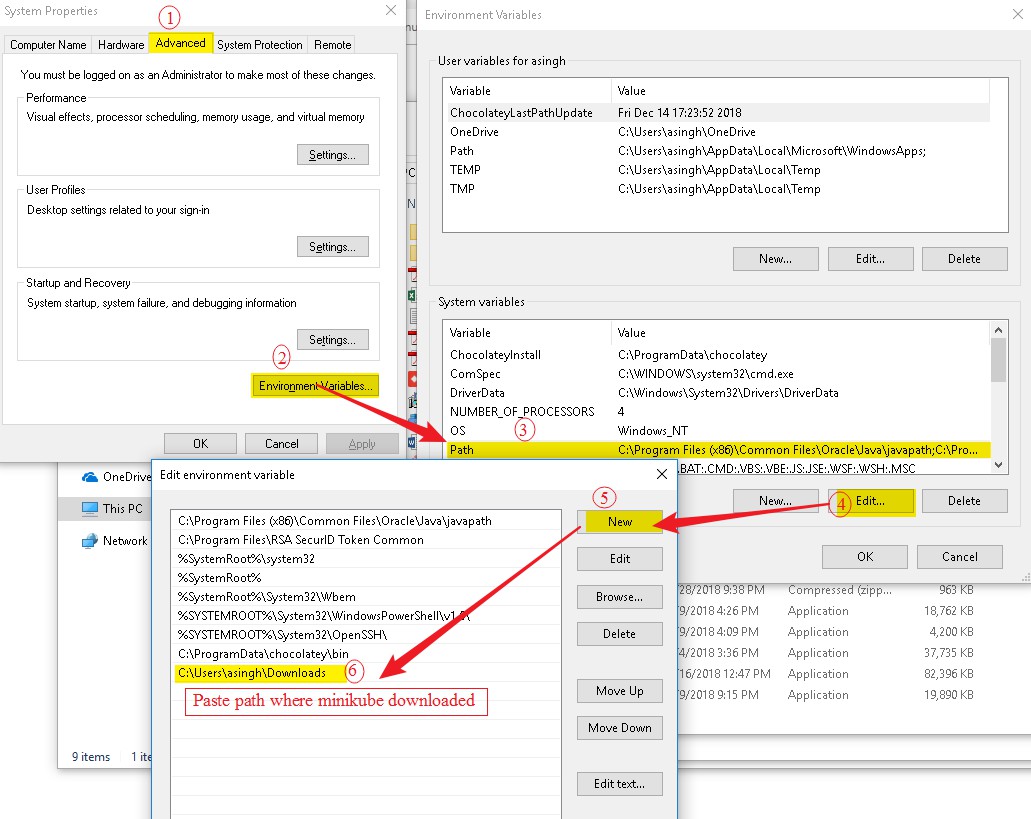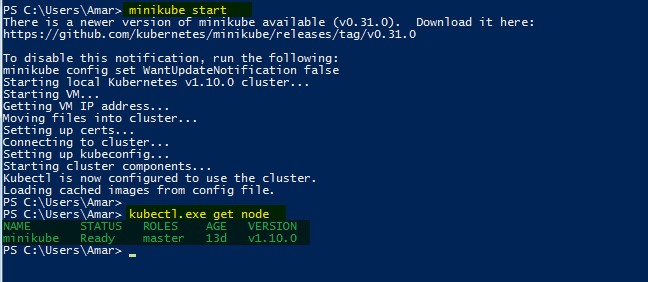Build Single Node kubernetes Cluster using MiniKube
Kubernetes: Kubernetes is an open source system for automatic deployment, scaling, and management of containerized applications.
MiniKube: MiniKube is a tool that makes it easy to run a single node kubernetes cluster locally. MiniKube runs a single-node Kubernetes cluster on a Virtual machine inside of your laptop.
Kubernetes Features in MiniKube:
-DNS -Node Port
-Dashboard
-Enable CNI (container Network Interface)
-ConfigMap and Secrets
-Ingress**
-Container Runtime: Docker, rkt, CRI-O and container**
Prerequisites: -A Windows Machine with admin access
-Installed Virtual box in Windows machine
-Installed Powershell
-VT-x or AMD-v Virtualization enabled
Installation: Follow the steps below for the installation steps:
Step 1- Install a Hypervisor: In my this blog I'm using Windows machine to install MiniKube, So I'll use VirtualBox as a hypervisor. Download and install the latest version of VirtualBox from its official site.
Step 2- Install Chocolatey package manager: Chocolatey also know as choco, it's a windows package manager. Using choco you can install a package like we do in Linux system. Let's install choco package manager in your windows machine followed by this command. Open Powershell Run as administrator:
PS C:\> Set-ExecutionPolicy Bypass -Scope Process -Force; iex ((New-Object System.Net.WebClient).DownloadString('https://chocolatey.org/install.ps1'))
Command output should be like this, there are some warnings, you can ignore them.
Verify choco installation and check the version
PS C:\> choco version
Step 3- Install Kubernetes-cli: Kubernetes-cli knows as kubectl, It is command line utility to create and manage Kubernetes cluster resource. Run the following command to install kubectl.
PS C:\> choco install kubernetes-cli
Installation output would be like this

Step 4- Download and set MiniKube environment path:
Download and Install Minikube Windows installer from its official repository.
Once download finish keeps it somewhere in a directory and renames it to minikube. and set an environment variable.
-Go to System properties advanced tab
-Environment variable
-Select path under system variable
-click on Edit
-Click on New
-Paste path where Minikube available and click on Ok.
in my case, I have it in my download folder. Please follow steps as in the image below.

Step 5- Start Minikube After successful installation of dependencies and Minikube, it's time to start minikube. run the following command at Powershell to start minikube.
PS C:\> minikube start
The above command will start kubernetes cluster, download minikube ISO, and create a VM like in below image.
TO get node details run command kubectl get node:
PS C:\> kubectl get node
NAME STATUS ROLES AGE VERSION
minikube Ready master 13d v1.10.0
Your Single node Kubernetes cluster is ready.
Step 6- Create your first deployment: In order to run your container, we need to create deployment first. let's run the following command to create the deployment. We can use .yml or .json file to create deployment but in this blog, we are using a single command to create deployment and service in step 7.
PS C:\> kubectl run web --image=httpd:2.4 --port=80
Where:
Kubectl run - command to create a deployment
web - Deployment name
--image=httpd2.4 - To define docker image path
--port=80 - Define port on which your app running.
Verify created Deployment:
PS C:\> kubectl get deployment
NAME DESIRED CURRENT UP-TO-DATE AVAILABLE AGE
web 1 1 1 1 44s
Check created pods:
PS C:\> kubectl get pods
NAME READY STATUS RESTARTS AGE
web-c86cff74-r9rpb 1/1 Running 0 45s
our deployment created successfully and the pod is available and running. Step 7- Create Service to expose deployment using type NodePort: Once deployment created successfully, let's create service to access container application from outside. Kubernetes support multiple methods to expose our deployment i.e. NodePort and LoadBalancer. let's follow the below command to expose our deployment.
PS C:\> kubectl expose deployment web --type=NodePort --name=webservice
Let's verify exposed service.
PS C:\> kubectl get service
NAME TYPE CLUSTER-IP EXTERNAL-IP PORT(S) AGE
kubernetes ClusterIP 10.96.0.1 <none> 443/TCP 16d
webservice NodePort 10.101.114.59 <none> 80:31178/TCP 9s
Deployment exposed successfully for external access.
Step 8- Verify exposed deployment's external access: To verify external access of deployment. first, check minikube IP address. Run the following command.
PS C:\> minikube ip
192.168.99.100
My Minikube IP address is 192.168.99.100. Now, let's check our exposed service port.
PS C:\> kubectl get service
NAME TYPE CLUSTER-IP EXTERNAL-IP PORT(S) AGE
webservice NodePort 10.101.114.59 <none> 80:31178/TCP 6m
So, our exposed deployment running with port 31178. Now Open browser and hit minikube IP and Port 31178 to check external access.

Step 9- Expose deployment using service Type LoadBalancer: In step 7 we exposed our deployment using NodeType service. Now let's use service type Loadbalancer.
PS C:\> kubectl expose deployment web --type=LoadBalancer--name=webservicelb
Verified created service:
PS C:\> kubectl get service
NAME TYPE CLUSTER-IP EXTERNAL-IP PORT(S) AGE
kubernetes ClusterIP 10.96.0.1 <none> 443/TCP 16d
webservice NodePort 10.101.114.59 <none> 80:31178/TCP 17m
webservicelb LoadBalancer 10.100.184.197 <pending> 80:30484/TCP 11s
Deployment exposed using service type LoadBalancer. Let's verify external access using minikube IP and LoadBalancer port (30484)
Step 9- Scale our deployment: Using Kubernetes, we can scale our deployment anytime. our current deployment has a single pod. you can verify it by running a command- kubect get pods. In order to scale our deployment let's use following command.
PS C:\> kubectl scale deployment web --replicas=2
Above command will scale our deployment and no of running pods will be 2. let's verify running pods using the command below.
PS C:\> kubectl get pods
NAME READY STATUS RESTARTS AGE
web-c86cff74-qntmh 0/1 ContainerCreating 0 10s
web-c86cff74-r9rpb 1/1 running 0 33m
We just scaled our deployment and you can see new Pod creation is in progress. Run above command again to verify that both pods are available and running.
PS C:\> kubectl get pods
NAME READY STATUS RESTARTS AGE
web-c86cff74-qntmh 1/1 Running 0 2m
web-c86cff74-r9rpb 1/1 Running 0 35m
Verified and our second pod available and running.
We have successfully built our single node Kubernetes cluster using Minikube and were able to built deployment, Service and pods.
Step 10- Delete service: Once, you have done with the testing and you want to delete service, run the following command.
PS C:\> kubectl delete service/webservicelb
Where
Kubectl delete - is a command
Service - is a command
webservicelb - is your service name
Step 11- Delete Deployment: In order to stop pods, we need to delete our deployment. run the command below to delete deployment.
PS C:\> kubectl delete deployment/web
In the above command web is your deployment. replace it with your deployment name to delete. Successfully deleted deployment and service. Now, if you will run the command kubectl get pods output will be null.
PS C:\> kubectl get pods
No resources found.
Step 12- Run Minikube dashboard in the browser: Minikube gives us the GUI interface to manage kubernetes cluster resource. To access GUI dashboard run the below com
PS C:\> minikube dashboard
Opening http://127.0.0.1:51503/api/v1/namespaces/kube-system/services/http:kubernetes-dashboard:/proxy/ in your default
browser...
The above command will open your default browser window and you will see kubernetes cluster resource in the GUI window.
Thanks for reading. Please leave your comments in order to improve





